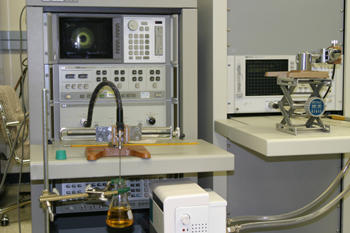Summary
In this project we measure the fundamental electrical properties of materials from bulk to nanoscale from 1 MHz to 0.3 THz. Understanding the interaction of microwaves with materials and the electrical properties of materials is very important to the development of new medical technologies and new electronics. The primary objectives of the EPM Project are to develop, improve, and analyze measurements of the electromagnetic properties of materials from the large-scale down to the nanoscale. The emphasis for the program is on measurement methods for substrates, thin films, liquids, biological materials, and artificial materials. Our program will advance the state of the art by introducing advanced concepts based on the underlying physics that govern the nature and properties of the materials.
Description

Electromagnetic devices cannot operate without the interaction of electromagnetic waves with materials, and the characterization of the interface between fields and materials will be a critical task for any device or metrology development from nanoscale to larger scales. Areas of impact over the next 5 to 10 years will be developing measurements at frequencies approaching 1 terahertz, defining theoretical concepts, and developing the optimum measurement tools to extend electromagnetic metrology and reference materials to the nanoscale. We will develop quantitative electromagnetic measurements of thin-film electronic materials, liquids, biomaterials, and other advanced materials over a wide range of experimental conditions including frequency, temperature, and magnetic fields. EEEL is performing state-of-the-art research that anticipates the measurement needs of industry years in advance in nondestructive substrate measurements, micro-fluidics, low- thin-film characterization, and near-field probing techniques. Industry, universities, other government laboratories, and standards committees have adopted many measurement methods. These include systems and test fixtures, best practices, and documentary standards. This work directly benefits and leads basic research and development in microelectronics, biotechnology, and nanotechnology and influences a wide range of commercial, military, and homeland security applications.
Major Accomplishments
Accomplishments:
• Constructed and evaluated a liquid test fixture for the Transportation Security Administration (TSA).
• Completed a study of the interaction of radio-frequency to terahertz electromagnetic fields with material sizes from the macroscopic to nanoscale.
• Completed an electromagnetic analysis of near-field nanoscale probes.
• Completed an analysis of split-post and split-cylinder resonance techniques.
• Performed on-wafer metrology to study printed wiring board measurement problems.
Associated Publications/Reports:
• J. Baker-Jarvis, M. D. Janezic, J. H. Lehman, "Dielectric-Resonator Method for Measuring the Electrical Conductivity of Carbon Nanotubes from Microwave to Millimeter Frequencies," Journal of Nanomaterials, vol. 2007, 12086, June 2007.
• J. Baker-Jarvis, M. D. Janezic, D. Love, T. M. Wallis, C. L. Holloway, P. Kabos, "Phase Velocity in Resonant Structures," IEEE Transactions on Magnetics, vol. 42, pp. 3344-3346, October 2006.
• M. Janezic, J. Jargon, J. R. Baker-Jarvis, "Relative Permittivity Measurements Using the Higher-Order Resonant Mode of a Near-Field Microwave Probe," International Union of Radio Science (URSI) (Chicago, IL), August 2008.

